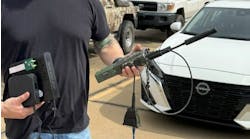by: Don McCarty
Last month we asked a few questions pertaining to fault locating in the copper infrastructure. Below are the answers with explanations.
1. The manufactured capacitance characteristics of an exchange cable pair can vary from:
A. .076 microfarads per mile to .090 microfarads per mile
The answer is A. The average mutual (tip-to-ring) capacitance is .083 microfarads per mile (51.6 Nano farads per Kilometer for you Canadian folks).
2. The varying twist length of adjacent pairs in a telephone cable controls:
A. Crosstalk
The answer is A. The twist length varies from 2 inches per twist up to 4.7 inches per twist in each 25 pair sub unit mitigating crosstalk to adjacent circuits.
3. When testing faulted pairs tip-to-ring in a wet pulp cable with no voltage present, a VOM will show a short from:
B. 2,000 ohms to about 50,000 ohms
The answer is B. A damp pulp cable may show higher than 50,000 ohms, but a soaking wet pulp cable will rarely show a short more solid than 2,000 ohms.
4. When testing pairs in wet air core PIC, the VOM will show crossed battery on:
A. The ring conductor
B. The shield
C. Both
The answer is C. The pattern of symptoms shows battery on the ring conductor only with tip conductors testing clear. The battery on the isolated shield will measure from 15 to 30 VDC in wet air core PIC.
5. When converting an ohms measurement to sheath footage, the technician must account for:
A. Gauge
B. Temperature
C. Wire composition
D. Helical cable design
E. All the above
The answer is E. Heavier gauges show less resistance per foot. Higher temperatures show less footage than lower temperatures. Some conductors are copper/steel showing more resistance thus less footage. The conductor is longer than the cable sheath so the twist must be accounted for.
6. When using a portable resistance bridge, a separate good pair strung along the ground must:
D. Be strapped to the faulted conductor at the far end
The answer is D. The requirements for a good pair are it must test clean, strapped at the far end with a 0 ohm strap, and the test set connected to the near end.
7. A resistance bridge measures all wire in a test section, including any laterals.
(True) (False)
The answer is False. A fault anywhere down a lateral will measure to the lateral branch splice.
8. A gauge change will not affect resistance measurements.
(True) (False)
The answer is False. A larger gauge will show less footage than the cable section length and a smaller gauge will show more footage than the cable section length.
9. An open meter measures all wire, including any laterals.
(True) (False)
The answer is True. The open meter converts all capacitance to footage including a POTS splitter at the NID and any capacitance of the end user’s equipment.
10. The effect of induced AC on an unbalanced pair is:
C. Noise.
The answer is C. The customer may not hear the noise, but that noise will affect bandwidth.
11. When measuring the distance to an open with an open meter, and tip-and-ring open measurements differ, the correct distance is the:
A. Shorter
The answer is A. The longer measurement is inaccurate.
12. A Time Domain Reflectometer (TDR) accurately measures the distance to split cable pairs as long as:
B. There are no loads in the test section
The answer is B. A TDR cannot see beyond the first load coil.
13. When conductor or shield-to-earth fault locating with a sheath fault locator, an earth gradient appears at:
A. Test set ground
B. Conductor-to-earth faults
C. Shield-to-earth faults
D. All the above
The answer is D. There must be a path to earth or the earth frame will not pinpoint the fault.
14. A field technician is fault locating in a 700-foot section of air core PIC cable. There are no other accesses. After he sets the proper gauge and conductor temperature, his resistance bridge measures 500 feet Distance-to-Strap. After removing the strap, his open meter, set to the proper capacitance of the cable, sees 700 feet. Marvin decides the test sets don’t work. What do you think is going on?
A. Water in the section
The answer is A. Water shorts out the capacitance causing the open meter to measure long.
15. The minimum acceptable loop current for an exchange cable pair, measured at the protector with a transmission test set, is:
B. 23 mA
The answer is B. Some constant current remotes operate at 21.6 mA. They are an exception to the 23 mA rule.
16. Maximum acceptable station ground resistance is:
C. 25 ohms
The answer is C. More than 25 ohms may cause freezing or pixelation on IPTV, and cause modems to drop.
17. When testing the subscriber’s pair at the protector with a transmission test set, Noise Metallic (NM) is unacceptable and Power Influence (PI) is acceptable, suspect:
A. Series resistance on the pair
B. One side open on a lateral
C. One side open beyond the subscriber
D. Crossed with a nonworking conductor
E. Any the above
The answer is E. Any of the above problems will affect the longitudinal balance of the circuit.
18. The amplitude of a telephone signal is attenuated by:
D. Capacitance
The answer is D. The more capacitance there is in the circuit, the lower the amplitude of the circuit. Higher frequencies are affected more than lower frequencies.
19. Marvin is chasing resistive trouble in aerial plant in the hot sun. He measures Strap-to-Fault as 1,500 feet of 24 gauge at 110 degrees. His map shows the aerial goes buried 750 feet away. At the point where the cable goes buried, the map shows a gauge change to 2,700 feet of 22 gauge. The underground temperature is 84 degrees. Marvin decides it’s either cut-to-clear or make an illegal "repairman’s access" at the pole. But he has all the information needed to go straight to the fault.
What is the actual STF footage to the fault when measured with a tape measure or an engineering wheel?
To convert from 110 degrees to 84 degrees is a 26-degree error. To calculate the temperature error:
.00218 feet of error
X 26 degrees
X 750 feet of error
= 42.5 feet of error
When converting from a higher to a lower temperature this distance is added showing 792.5 feet of 24 gauge measurement.
To convert from 24 gauge to 22 gauge multiply 792.5 X 1.6 = 1,268 feet of 22 gauge to the fault. Add the 750 feet of 24 gauge to the fault showing 2,018 sheath feet to the fault from the strap.
Signing off
Some of today’s multifunctional test sets have a multi-gauge and a multi-temperature conversion feature built into their resistance bridge. My TechEXPERT program has a gauge and temperature converter built into the program. If you are interested in more questions, drop me an email. [email protected] or call me at 831.818.3930 (mobile). And, check out my TALK BACK online column and tell me what you think: http://www.ospmag.com/columnists/mccarty/talkback.




